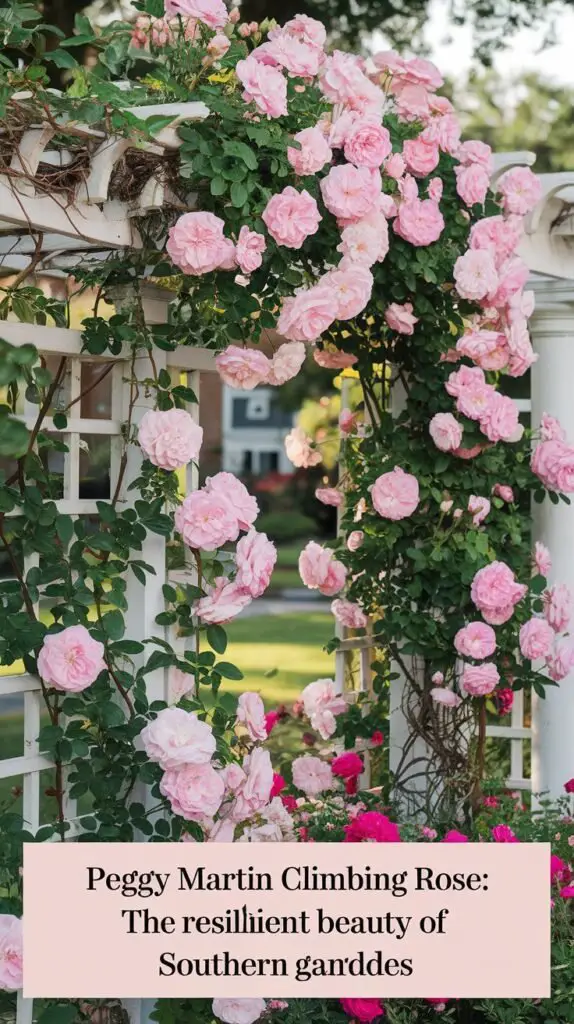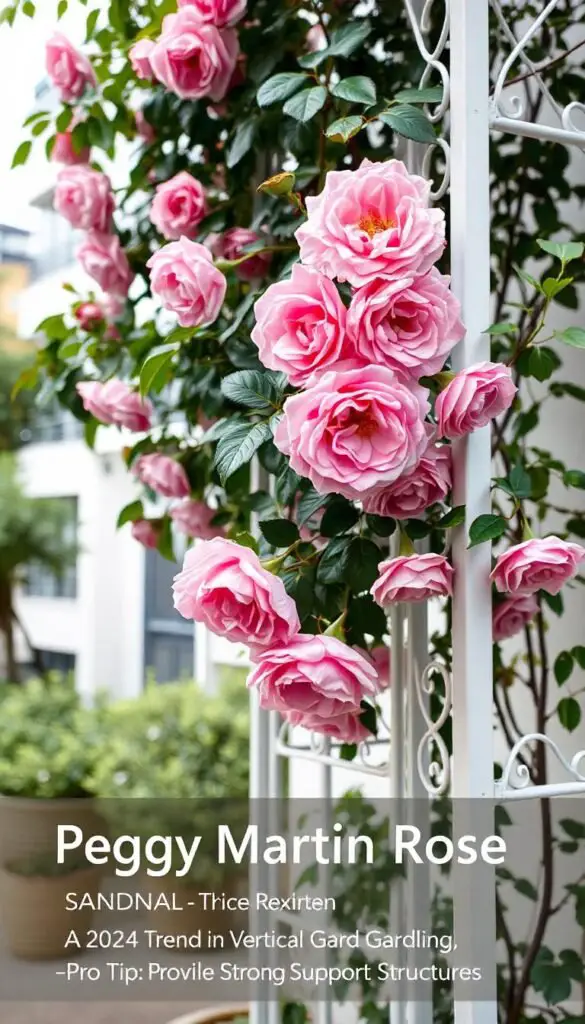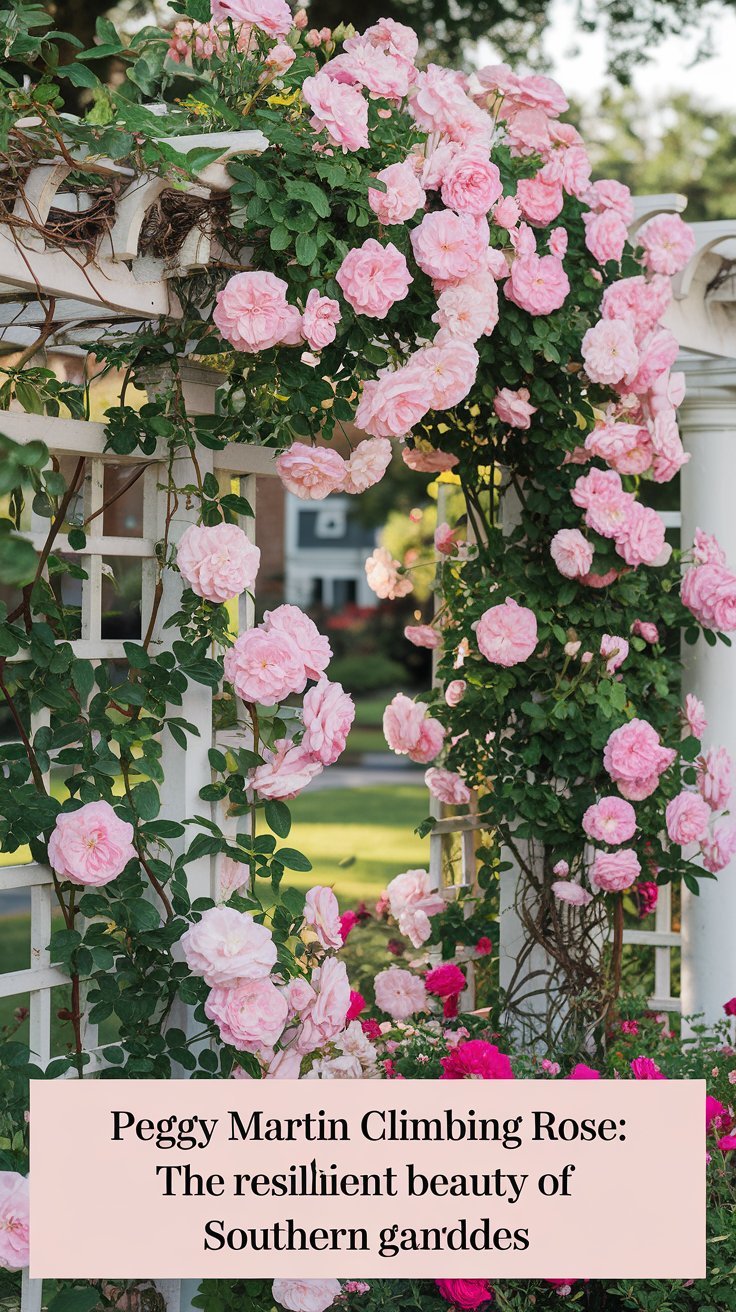Discover the Peggy Martin climbing rose, a resilient and stunning addition to any garden. Learn about its history, care tips and why it’s become a symbol of hope and renewal in Southern horticulture. Perfect for both novice and experienced gardeners in 2024.
The Peggy Martin climbing rose, often called the “Katrina Rose,” is a testament to resilience and beauty in the world of horticulture. This stunning climber, with its cascading clusters of pink blooms, has captured the hearts of gardeners across the Southern United States and beyond. Known for its vigorous growth, disease resistance, and ability to thrive in diverse conditions, the Peggy Martin rose has become more than just a plant – it’s a symbol of hope and renewal in the face of adversity.
As a rosarian with over two decades of experience cultivating and studying roses, particularly those suited to Southern climates, I’m thrilled to share my insights on this remarkable climbing rose. Let’s delve into the world of the Peggy Martin rose and discover why it’s become a favorite among gardeners and landscapers alike.
The Inspiring History of the Peggy Martin Rose

A Rose of Survival
The story of the Peggy Martin rose is as compelling as the plant itself:
- Originally grown in New Orleans, Louisiana
- Survived 20 feet of saltwater flooding during Hurricane Katrina in 2005
- One of only two plants in Peggy Martin’s garden to survive the disaster
2024 Update: The Peggy Martin rose continues to be planted in community restoration projects, symbolizing resilience in the face of climate-related challenges.
Historical Significance: This rose’s survival has made it a living symbol of the resilience of the Gulf Coast region.
Characteristics of the Peggy Martin Rose

Appearance and Growth Habit
- Bloom Color: Soft pink
- Bloom Type: Semi-double
- Fragrance: Mild, sweet scent
- Growth Habit: Vigorous climber, can reach 15-20 feet
2024 Trend: Landscape architects are increasingly incorporating the Peggy Martin rose into vertical gardening designs for urban spaces.
Pro Tip: Provide strong support structures like trellises or arbors to showcase this rose’s climbing ability.
Growing Conditions
- Hardiness: USDA zones 4-9
- Sun Exposure: Full sun to partial shade
- Soil Requirements: Well-draining, slightly acidic soil
2024 Research: New studies are exploring the Peggy Martin rose’s potential for phytoremediation in areas affected by saltwater intrusion.
Cultivation Insight: This rose’s adaptability makes it an excellent choice for challenging garden conditions.
Planting and Care Guide
Planting Your Peggy Martin Rose
- Choose the Right Location: Select a spot with adequate sunlight and room for growth.
- Prepare the Soil: Amend with organic matter for optimal nutrition.
- Planting Depth: Plant at the same depth as it was in its container.
- Spacing: Allow 6-8 feet between plants for proper air circulation.
2024 Innovation: New biodegradable planting containers are making it easier to transplant roses without disturbing the root system.
Expert Advice: Plant in spring or fall for the best establishment results.
Ongoing Care
Watering
- Frequency: Deep, infrequent watering
- Method: Drip irrigation or soaker hoses to avoid wetting foliage
2024 Trend: Smart irrigation systems tailored for rose gardens are gaining popularity, optimizing water usage based on real-time weather data.
Water-Wise Tip: Mulch around the base to retain moisture and suppress weeds.
Fertilizing
- Schedule: Feed in early spring and mid-summer
- Type: Balanced, slow-release rose fertilizer
2024 Update: Organic, seaweed-based fertilizers are showing promising results in enhancing the Peggy Martin rose’s disease resistance.
Nutrition Insight: Avoid over-fertilizing, which can lead to excessive foliage growth at the expense of blooms.
Pruning
- Timing: Late winter or early spring before new growth begins
- Method: Remove dead or crossing branches; shape as desired
2024 Technique: Espalier training of the Peggy Martin rose is becoming a popular method for creating living privacy screens.
Pruning Tip: This rose blooms on old wood, so avoid heavy pruning to ensure abundant flowering.
Disease and Pest Resistance
One of the Peggy Martin rose’s standout features is its excellent resistance to common rose ailments:
- Highly resistant to black spot and powdery mildew
- Shows good resistance to common rose pests
2024 Research: Ongoing studies are investigating the genetic factors contributing to the Peggy Martin rose’s robust disease resistance.
Ecological Benefit: This rose’s natural resistance makes it an excellent choice for organic and low-maintenance gardens.
Landscaping with the Peggy Martin Rose
Design Ideas
- Vertical Accent: Train along fences or walls for a stunning floral display.
- Arbor Coverage: Create a romantic walkway with a Peggy Martin-covered arbor.
- Companion Planting: Pair with lavender or catmint for a beautiful color contrast.
2024 Trend: Incorporating the Peggy Martin rose into rain gardens is gaining popularity due to its resilience and adaptability.
Design Tip: Use the cascading growth habit to soften hardscaping elements in the garden.
The Peggy Martin Rose in Southern Culture
Beyond its horticultural value, the Peggy Martin rose has become a cultural icon in the Southern United States:
- Featured in numerous garden tours and exhibitions
- Symbolizes hope and renewal in post-disaster landscapes
- Increasingly popular in heritage garden restorations
2024 Cultural Impact: The Peggy Martin rose is being incorporated into public art installations across the Gulf Coast, blending horticulture with community storytelling.
Community Engagement: Look for local “Peggy Martin Rose Planting Days” as community-building events in areas recovering from natural disasters.
The Enduring Legacy of the Peggy Martin Rose
The Peggy Martin climbing rose is more than just a beautiful plant; it’s a living testament to the resilience of nature and the human spirit. Its ability to thrive in challenging conditions, coupled with its stunning displays of pink blooms, makes it a valuable addition to any garden.
Whether you’re a seasoned rosarian or a novice gardener, the Peggy Martin rose offers beauty, inspiration, and relatively easy care. As we face increasing environmental challenges, this remarkable rose reminds us of the power of adaptation and the enduring beauty of the natural world.
For more information on roses and their care, visit resources like the American Rose Society or your local cooperative extension office. Happy planting, and may your garden be graced with the resilient beauty of the Peggy Martin rose!
For more gardening tips and plant care guides, visit usagardenhub.com





One comment on “Peggy Martin Climbing Rose : The Resilient Beauty of Southern Gardens”